How to use the RANDARRAY function
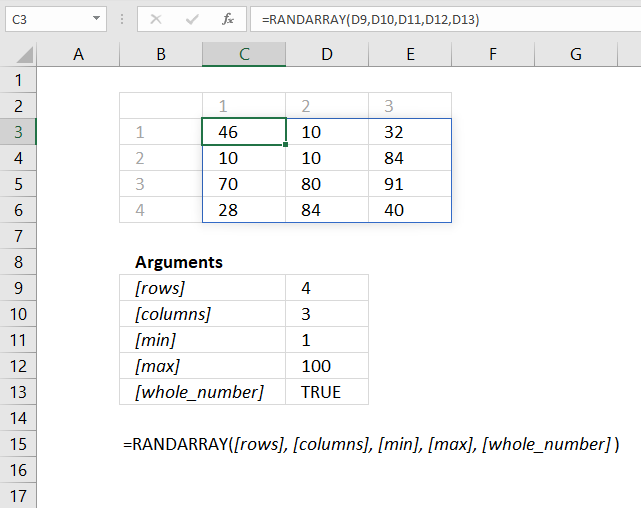
What is the RANDARRAY function?
The RANDARRAY function returns a table of random numbers across rows and columns.
It is located in the Math and Trigonometry category and is only available to Excel 365 subscribers.
What's on this page
Webpages containing the RANDARRAY function
1. Introduction
What is random?
Each outcome of a random process cannot be predicted with certainty before it occurs. It is unpredictable.
Is the RANDARRAY function random?
No, it is pseudo-random. The generated value is not truly random.
What is pseudo-random?
Random numbers created by software like Excel are not truly random, they can be predicted. That is why they are called pseudo-random meaning they look like random values but they are not.
What is volatile?
The function is volatile meaning a new random real number is returned every time the worksheet is calculated.
What is the effect of volatile functions?
They may slow down your worksheet/workbook if you have many volatile functions.
When is the worksheet calculated?
Cells containing non volatile functions are only calculated once or until you force a recalculation, however, volatile functions are recalculated each time you type in a cell and press enter.
Can you stop recalculating a worksheet?
Yes, you can change a setting to manual recalculations.
- Go to tab "Formulas".
- Press with left mouse button on the "Calculation Options" button, a popup menu appears.
- Press with mouse on "Manual".
This stops the automatic recalculations.
How to force a recalculation?
Pressing F9 key will recalculate or refresh all the formulas and values in every worksheet of every workbook you have open.
Pressing Shift+F9 will only recalculate the formulas and values on the single worksheet you're currently viewing or active.
Pressing Ctrl+Alt+F9 is the quickest way to force a full recalculation of absolutely everything in all open workbooks, even if nothing has changed. It ignores whether changes were made or not and completely recomputes.
Are there more volatile functions in Excel?
Yes. OFFSET, TODAY, NOW among others.
| Function | Syntax | Description |
|---|---|---|
| OFFSET | OFFSET(reference, rows, cols) | Returns a cell offset from a reference cell. |
| TODAY | TODAY() | Returns the current date. |
| NOW | NOW() | Returns current date and time. |
| RANDARRAY | RANDARRAY([rows], [columns], [min], [max], [whole_number]) | Returns an array with random numbers. |
| RANDBETWEEN | RANDBETWEEN(bottom, top) | Returns a random whole number between bottom and top |
Note, that conditional formatting is extremely volatile or super-volatile meaning it is recalculated as you scroll through a worksheet.
What other functions return random values?
| Excel Function | Syntax | Description |
|---|---|---|
| RAND() | RAND() | Returns a random decimal number between 0 and 1 |
| RANDBETWEEN | RANDBETWEEN(bottom, top) | Returns a random whole number between bottom and top |
| RANDARRAY | RANDARRAY([rows], [columns], [min], [max], [whole_number]) | Returns an array with random numbers. |
What is a spilled array formula?
Excel 365 automatically expands the output range based on the number of values in the array, without requiring the user to enter the formula as an array formula.
This new behavior of Excel is called spilled array formula and is something only dynamic array formulas can do. Dynamic array formulas are only available to Excel 365 subscribers.
2. Syntax
RANDARRAY([rows], [columns], [min], [max], [whole_number])
| Arguments | Text |
| [rows] | Optional. Number of rows., 1 is the default value. |
| [columns] | Optional. Number of columns, 1 is the default value. |
| [min] | Optional. The smallest number. |
| [max] | Optional. The largest number. |
| [whole_number] | Optional. TRUE - whole number. FALSE - decimal number. |
3. Example 1

This image shows an Excel spreadsheet demonstrating the use of the RANDARRAY function. The main part of the image shows a 4x3 table (cells C3:E6) filled with random numbers. These numbers are whole numbers ranging from 1 to 100.
Above this table in the formula bar we can see the formula used to generate these random numbers:
Formula in cell B3:
Below the main table, there's a section labeled "Arguments" that shows the arguments used in the RANDARRAY function:
- [rows]: 4 - cell D9
- [columns]: 3 - cell D10
- [min]: 1 - cell D11
- [max]: 100 - cell D12
- [whole_number]: TRUE - cell D13
At the bottom of the image the RANDARRAY function syntax is shown:
RANDARRAY([rows], [columns], [min], [max], [whole_number])
This spreadsheet is set up to demonstrate how the RANDARRAY function works in Excel. It generates a table of random numbers based on the specified parameters: 4 rows, 3 columns, with whole numbers between 1 and 100.
The function is versatile and can be adjusted by changing the arguments in cells D9:D13 to generate different sizes of arrays with different ranges of numbers, either whole numbers or decimals.
The formula demonstrated in the image above returns a table of four rows and three columns populated with random numbers from 1 to 100. The formula returns new values every time you press F9.
4. Example 2
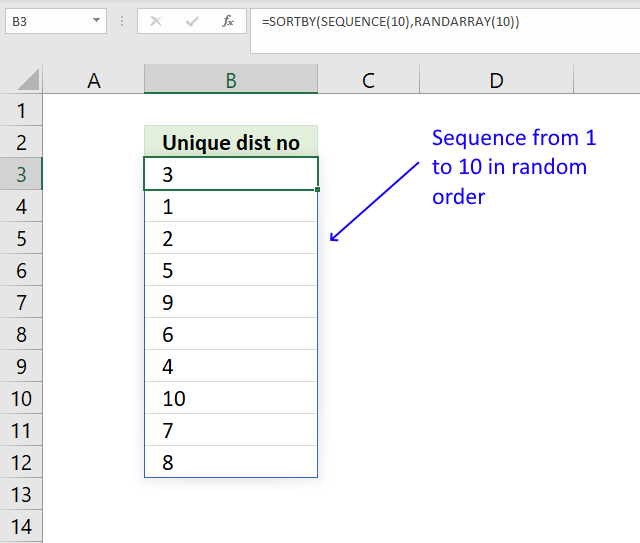
How to create a list of unique distinct numbers sorted in random order?
The image above shows a formula in cell B3 that returns numbers from one to ten in random order. Press F9 to create a new random list from 1 to 10. The RANDARRAY function is volatile meaning each time the worksheet recalculates a new random list is created.
Formula in cell D3:
This is how the formula works basically:
- Create an array populated from 1 to 10. (SEQUENCE function)
- Create an array containing 10 random real numbers between 0 (zero) and 10. (RANDARRAY function)
- Sort the sequence of values 1...10 based on the array containing random real numbers. (SORTBY function)
The output array is displayed in cell D3:D12. You can easily customize this formula to your needs. For example, change 10 to 100 for all instances in the formula to output 100 random numbers from 1 to 100.
Explaining formula in cell D3
The following steps describe the formula calculations in much greater detail.
Step 1 - Create an array of random no between 0 (zero) and 1
RANDARRAY(10)
returns
{0.00631985584666483; 0.846522787602261; 0.817086790647678; 0.0907043159731944; 0.831202119264657; 0.218031433770172; 0.505530171355597; 0.80026556794421; 0.853884408869484; 0.487721931499081}
Step 2 - Create an array of numbers between 1 and 10
The SEQUENCE function returns a sequence of numbers. SEQUENCE(rows, [columns], [start], [step])
SEQUENCE(10)
returns
{1; 2; 3; 4; 5; 6; 7; 8; 9; 10}
Step 3 - Sort sequence based on random numbers
The SORTBY function sorts the sequence of numbers based on the array of random numbers. SORTBY(array, by_array1, [sort_order1], [by_array2, sort_order2],…)
SORTBY(SEQUENCE(10),RANDARRAY(10))
becomes
SORTBY({1; 2; 3; 4; 5; 6; 7; 8; 9; 10}, {0.00631985584666483; 0.846522787602261; 0.817086790647678; 0.0907043159731944; 0.831202119264657; 0.218031433770172; 0.505530171355597; 0.80026556794421; 0.853884408869484; 0.487721931499081})
and returns
{8; 5; 3; 7; 10; 9; 1; 2; 6; 4}.
5. Example 3
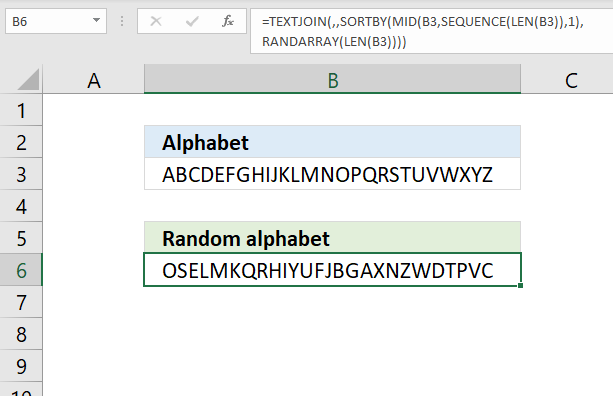
How to shuffle characters in a text string randomly?
The image above shows a formula in cell B6 that returns characters in random order based on the original text string in cell B3. This example uses the entire alphabet "ABCDEFGHIJKLMNOPQRSTUVWXYZ" as the source string and returns "OSELMKQRHIYUFJBGAXNZWDTPVC" which is a string containing all the letters in random order.
Formula in cell D3:
This is, basically, how the formula works :
- Count characters in cell B3 (LEN function)
- Create a sequence from 1 to n where n is the number of characters. (SEQUENCE function)
- Split each character in cell B3 to form an array. (MID function)
- Create an array containing random real numbers from 0 (zero) to 1. The array has the same number of values as there are characters in cell B3. (RANDARRAY function)
- Sort characters in the array based on real numbers in the other array. (SORTBY function)
- Join the characters and return the output to cell D3. (TEXTJOIN function)
Explaining formula in cell D3
The following steps describe the formula calculations in much greater detail.
Step 1 - Count rows in cell range
The LEN function counts the number of characters in a string.
LEN(B3)
Step 2 - Create sequence based on the number of characters in B3
The SEQUENCE function returns a sequence of numbers. SEQUENCE(rows, [columns], [start], [step])
SEQUENCE(LEN(B3))
becomes
SEQUENCE(26)
and returns
{1; 2; 3; 4; 5; 6; 7; 8; 9; 10; 11; 12; 13; 14; 15; 16; 17; 18; 19; 20; 21; 22; 23; 24; 25; 26}
Step 3 - Split text string into characters
The MID function returns a substring from a string based on the starting position and the number of characters you want to extract. MID(text, start_num, num_chars)
MID(B3, SEQUENCE(LEN(B3)), 1)
becomes
MID("ABCDEFGHIJKLMNOPQRSTUVWXYZ", {1; 2; 3; 4; 5; 6; 7; 8; 9; 10; 11; 12; 13; 14; 15; 16; 17; 18; 19; 20; 21; 22; 23; 24; 25; 26}, 1)
and returns
{"A"; "B"; "C"; "D"; "E"; "F"; "G"; "H"; "I"; "J"; "K"; "L"; "M"; "N"; "O"; "P"; "Q"; "R"; "S"; "T"; "U"; "V"; "W"; "X"; "Y"; "Z"}
Step 4 - Create an array of random numbers
RANDARRAY(LEN(B3))
becomes
RANDARRAY(26)
and returns an array of 26 random decimal numbers.
Step 5 - Sort array of characters based on random numbers
The SORTBY function sorts the characters based on the array of random numbers. SORTBY(array, by_array1, [sort_order1], [by_array2, sort_order2],…)
SORTBY(MID(B3, SEQUENCE(LEN(B3)), 1), RANDARRAY(LEN(B3)))
becomes
SORTBY({"A"; "B"; "C"; "D"; "E"; "F"; "G"; "H"; "I"; "J"; "K"; "L"; "M"; "N"; "O"; "P"; "Q"; "R"; "S"; "T"; "U"; "V"; "W"; "X"; "Y"; "Z"}, RANDARRAY(LEN(B3)))
and returns
{"T"; "H"; "L"; "R"; "F"; "X"; "O"; "V"; "K"; "S"; "G"; "D"; "B"; "Q"; "U"; "J"; "P"; "C"; "I"; "E"; "Z"; "Y"; "A"; "W"; "M"; "N"}
Step 6 - Join characters in array
The TEXTJOIN function concatenates the characters and returns a text string.
TEXTJOIN(, , SORTBY(MID(B3, SEQUENCE(LEN(B3)), 1), RANDARRAY(LEN(B3))))
becomes
TEXTJOIN(, , {"T"; "H"; "L"; "R"; "F"; "X"; "O"; "V"; "K"; "S"; "G"; "D"; "B"; "Q"; "U"; "J"; "P"; "C"; "I"; "E"; "Z"; "Y"; "A"; "W"; "M"; "N"})
and returns THLRFXOVKSGDBQUJPCIEZYAWMN.
6. Example 4
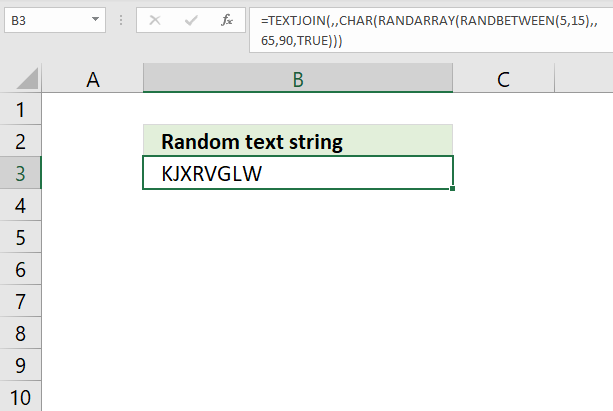
How to create a random text string?
The image above shows a formula that creates characters from A to Z with a total string length of 5 to 15 characters. Press F9 to recalculate the formula.
- The output string may be between 5 to 15 characters long.
- It contains capital letters A to Z.
- It returns a new set of characters every time the worksheet is recalculated.
Formula in cell B6:
This is, basically, how the formula works:
- Return a number n between 5 to 15. (RANDBETWEEN function)
- Create n integers between 65 to 90. (RANDARRAY function)
- Convert numbers to letters. (CHAR function)
- Join the letters. (TEXTJOIN function)
Explaining formula in cell D3
Step 1 - Create a random number between 5 and 15
The RANDBETWEEN function returns a random whole number between the numbers you specify. RANDBETWEEN(bottom, top)
RANDBETWEEN(5, 15)
For some reason I don't know the RANDARRAY function can' be used in the first argument in another RANDARRAY function, in other words, a nested RANDARRAY function does not work.
Step 2 - Create an array of whole numbers between
The RANDARRAY function returns an array of whole numbers between 65 and 90. The size of the array is determined by the output from the RANDBETWEEN function.
RANDARRAY(RANDBETWEEN(5, 15), , 65, 90,TRUE)
returns
{89; 69; 73; 66; 72; 89; 72; 89; 70; 81; 85; 65; 76; 68}
Step 3 - Convert numbers to letters
The CHAR function converts a number to the corresponding character.
CHAR(RANDARRAY(RANDBETWEEN(5, 15), , 65, 90,TRUE))
becomes
CHAR({89; 69; 73; 66; 72; 89; 72; 89; 70; 81; 85; 65; 76; 68})
and returns
{"Y";"E";"I";"B";"H";"Y";"H";"Y";"F";"Q";"U";"A";"L";"D"}
Step 6 - Join characters in array
The TEXTJOIN function concatenates the characters and returns a text string.
TEXTJOIN(, , CHAR(RANDARRAY(RANDBETWEEN(5, 15), , 65, 90,TRUE)))
becomes
TEXTJOIN(, , {"Y";"E";"I";"B";"H";"Y";"H";"Y";"F";"Q";"U";"A";"L";"D"})
and returns YEIBHYHYFQUALD.
7. Function not working
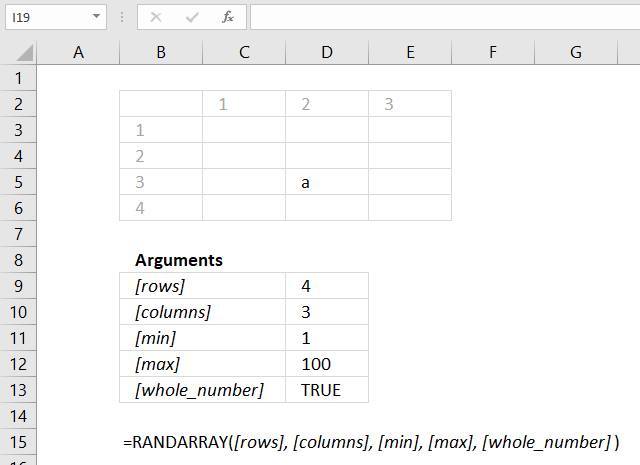
#SPILL! error is returned by the RANDARRAY function if the required cell range is populated by any other value. You have two options:
- Remove value leaving the cell blank.
- Enter the dynamic formula in another cell that has empty adjacent cells.
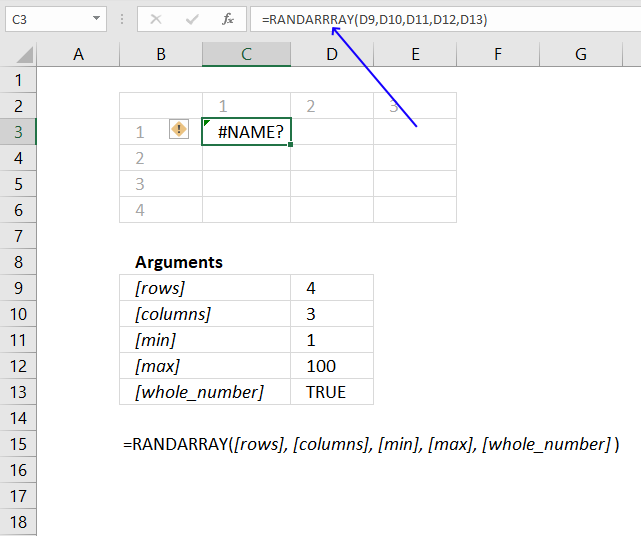
If a cell returns #NAME! error you have either misspelled the function name or you are using an older incompatible Excel version.
The image above shows that I misspelled the RANDARRAY function in the formula bar, cell F3 displays #NAME! error.
Only Excel 365 subscription version supports the new dynamic array formula like the RANDARRAY function, older Excel versions like Excel 2019, 2016, 2013, 2010, 2007, and earlier versions do not support the RANDARRAY function.
Here is how to find out your Excel version: Get your Excel version
7.1 Troubleshooting the error value

When you encounter an error value in a cell a warning symbol appears, displayed in the image above. Press with mouse on it to see a pop-up menu that lets you get more information about the error.
- The first line describes the error if you press with left mouse button on it.
- The second line opens a pane that explains the error in greater detail.
- The third line takes you to the "Evaluate Formula" tool, a dialog box appears allowing you to examine the formula in greater detail.
- This line lets you ignore the error value meaning the warning icon disappears, however, the error is still in the cell.
- The fifth line lets you edit the formula in the Formula bar.
- The sixth line opens the Excel settings so you can adjust the Error Checking Options.
Here are a few of the most common Excel errors you may encounter.
#NULL error - This error occurs most often if you by mistake use a space character in a formula where it shouldn't be. Excel interprets a space character as an intersection operator. If the ranges don't intersect an #NULL error is returned. The #NULL! error occurs when a formula attempts to calculate the intersection of two ranges that do not actually intersect. This can happen when the wrong range operator is used in the formula, or when the intersection operator (represented by a space character) is used between two ranges that do not overlap. To fix this error double check that the ranges referenced in the formula that use the intersection operator actually have cells in common.
#SPILL error - The #SPILL! error occurs only in version Excel 365 and is caused by a dynamic array being to large, meaning there are cells below and/or to the right that are not empty. This prevents the dynamic array formula expanding into new empty cells.
#DIV/0 error - This error happens if you try to divide a number by 0 (zero) or a value that equates to zero which is not possible mathematically.
#VALUE error - The #VALUE error occurs when a formula has a value that is of the wrong data type. Such as text where a number is expected or when dates are evaluated as text.
#REF error - The #REF error happens when a cell reference is invalid. This can happen if a cell is deleted that is referenced by a formula.
#NAME error - The #NAME error happens if you misspelled a function or a named range.
#NUM error - The #NUM error shows up when you try to use invalid numeric values in formulas, like square root of a negative number.
#N/A error - The #N/A error happens when a value is not available for a formula or found in a given cell range, for example in the VLOOKUP or MATCH functions.
#GETTING_DATA error - The #GETTING_DATA error shows while external sources are loading, this can indicate a delay in fetching the data or that the external source is unavailable right now.
7.2 The formula returns an unexpected value

To understand why a formula returns an unexpected value we need to examine the calculations steps in detail. Luckily, Excel has a tool that is really handy in these situations. Here is how to troubleshoot a formula:
- Select the cell containing the formula you want to examine in detail.
- Go to tab “Formulas” on the ribbon.
- Press with left mouse button on "Evaluate Formula" button. A dialog box appears.
The formula appears in a white field inside the dialog box. Underlined expressions are calculations being processed in the next step. The italicized expression is the most recent result. The buttons at the bottom of the dialog box allows you to evaluate the formula in smaller calculations which you control. - Press with left mouse button on the "Evaluate" button located at the bottom of the dialog box to process the underlined expression.
- Repeat pressing the "Evaluate" button until you have seen all calculations step by step. This allows you to examine the formula in greater detail and hopefully find the culprit.
- Press "Close" button to dismiss the dialog box.

There is also another way to debug formulas using the function key F9. F9 is especially useful if you have a feeling that a specific part of the formula is the issue, this makes it faster than the "Evaluate Formula" tool since you don't need to go through all calculations to find the issue.
- Enter Edit mode: Double-press with left mouse button on the cell or press F2 to enter Edit mode for the formula.
- Select part of the formula: Highlight the specific part of the formula you want to evaluate. You can select and evaluate any part of the formula that could work as a standalone formula.
- Press F9: This will calculate and display the result of just that selected portion.
- Evaluate step-by-step: You can select and evaluate different parts of the formula to see intermediate results.
- Check for errors: This allows you to pinpoint which part of a complex formula may be causing an error.
The image above shows cell reference D9 converted to hard-coded value using the F9 key. The RANDARRAY function requires numerical values in the first, second, third and fourth arguments which is not the case in this example. We have found what is wrong with the formula.
Tips!
- View actual values: Selecting a cell reference and pressing F9 will show the actual values in those cells.
- Exit safely: Press Esc to exit Edit mode without changing the formula. Don't press Enter, as that would replace the formula part with the calculated value.
- Full recalculation: Pressing F9 outside of Edit mode will recalculate all formulas in the workbook.
Remember to be careful not to accidentally overwrite parts of your formula when using F9. Always exit with Esc rather than Enter to preserve the original formula. However, if you make a mistake overwriting the formula it is not the end of the world. You can “undo” the action by pressing keyboard shortcut keys CTRL + z or pressing the “Undo” button
7.3 Other errors
Floating-point arithmetic may give inaccurate results in Excel - Article
Floating-point errors are usually very small, often beyond the 15th decimal place, and in most cases don't affect calculations significantly.
'RANDARRAY' function examples
Table of Contents Team Generator Dynamic team generator How to build a Team Generator - different number of people per […]
What's on this page Reverse text Insert random characters Convert letters to numbers How to shuffle characters in the alphabet […]
Functions in 'Math and trigonometry' category
The RANDARRAY function function is one of 62 functions in the 'Math and trigonometry' category.
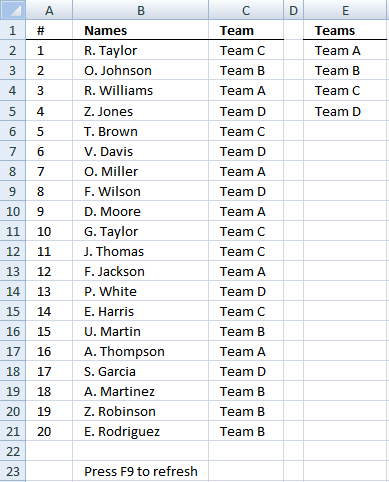
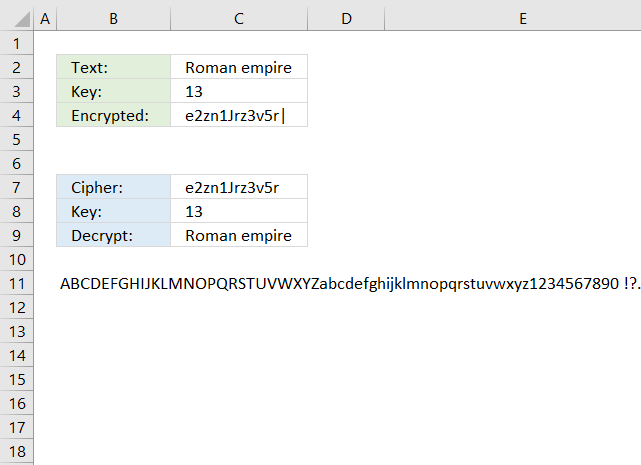
How to comment
How to add a formula to your comment
<code>Insert your formula here.</code>
Convert less than and larger than signs
Use html character entities instead of less than and larger than signs.
< becomes < and > becomes >
How to add VBA code to your comment
[vb 1="vbnet" language=","]
Put your VBA code here.
[/vb]
How to add a picture to your comment:
Upload picture to postimage.org or imgur
Paste image link to your comment.
Contact Oscar
You can contact me through this contact form